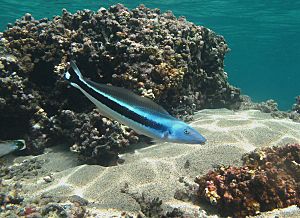Blue blanquillo facts for kids
Quick facts for kids Blue blanquillo |
|
|---|---|
 |
|
| Conservation status | |
|
Not evaluated (IUCN 3.1)
|
|
| Scientific classification | |
| Kingdom: | |
| Phylum: | |
| Class: | |
| Order: | |
| Family: |
Malacanthidae
|
| Genus: |
Malacanthus
|
| Species: |
M. latovittatus
|
| Binomial name | |
| Malacanthus latovittatus (Lacépède, 1801)
|
|
| Synonyms | |
|
|
The blue blanquillo (Malacanthus latovittatus) is a cool type of tilefish. People also call it the banded blanquillo or striped blanquillo. Sometimes it's even called the eye of the sea! This fish belongs to a family called Malacanthidae. It's the only species in its special group, the Malacanthus genus.
Contents
About the Blue Blanquillo
What Does It Look Like?
Blue blanquillos have sleek, smooth bodies. They also have a large crest, like a small ridge, on their heads. Their top fin (dorsal fin) and bottom fin (anal fin) are quite long.
This fish gets its name because it's mostly blue. It can also have yellow parts. What's super cool is that it can even change its colors! This happens depending on what's going on around it.
You'll see stripes running across its back. Its belly is usually white. When it's time for them to lay eggs, the color of their head can change. It goes from light blue to a mix of pink.
Where Do Blue Blanquillos Live?
You can find blue blanquillos in the Indo-Pacific Ocean. This huge area stretches from the Red Sea all the way to the Line Islands. They live as far north as southern Japan and south to New Caledonia and the Cook Islands.
These fish love to hang out near coral reefs. They are often seen close to the ocean floor.
How Do They Behave?
Blue blanquillos don't swim in big groups like some fish. You'll usually see them swimming alone. Sometimes, you might spot two of them together.
They are known to help other fish by cleaning them. They also do something clever called mimicking! They pretend to be a different fish, like a wrasse. This helps them avoid being eaten by predators.
These fish can swim pretty deep, usually about 20 to 22 meters (65 to 72 feet) down. The water they live in is usually warm, between 22 and 28 degrees Celsius (72 to 82 degrees Fahrenheit). They often swim a bit above the seafloor. This lets them use their excellent eyesight to spot food on the ground.
What Do They Eat?
The blue blanquillo mainly eats small creatures that live near the bottom of the sea. These include tiny invertebrates and zooplankton. They also enjoy eating crustaceans like crabs and shrimp. Other favorite foods are molluscs, worms, sea urchins, and even small fish.
Who Are Their Predators?
Bigger fish and reef sharks are some of the blue blanquillo's main predators. Humans also catch and eat them.
Images for kids


